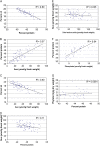Relationship between asparagine metabolism and protein concentration in soybean seed
- PMID: 22357599
- PMCID: PMC3350928
- DOI: 10.1093/jxb/ers039
Relationship between asparagine metabolism and protein concentration in soybean seed
Abstract
The relationship between asparagine metabolism and protein concentration was investigated in soybean seed. Phenotyping of a population of recombinant inbred lines adapted to Illinois confirmed a positive correlation between free asparagine levels in developing seeds and protein concentration at maturity. Analysis of a second population of recombinant inbred lines adapted to Ontario associated the elevated free asparagine trait with two of four quantitative trait loci determining population variation for protein concentration, including a major one on chromosome 20 (linkage group I) which has been reported in multiple populations. In the seed coat, levels of asparagine synthetase were high at 50 mg and progressively declined until 150 mg seed weight, suggesting that nitrogenous assimilates are pre-conditioned at early developmental stages to enable a high concentration of asparagine in the embryo. The levels of asparaginase B1 showed an opposite pattern, being low at 50 mg and progressively increased until 150 mg, coinciding with an active phase of storage reserve accumulation. In a pair of genetically related cultivars, ∼2-fold higher levels of asparaginase B1 protein and activity in seed coat, were associated with high protein concentration, reflecting enhanced flux of nitrogen. Transcript expression analyses attributed this difference to a specific asparaginase gene, ASPGB1a. These results contribute to our understanding of the processes determining protein concentration in soybean seed.
Figures


Similar articles
-
Correlation between AS1 gene expression and seed protein contents in different soybean (Glycine max [L.] Merr.) cultivars.Plant Biol (Stuttg). 2006 Mar;8(2):271-6. doi: 10.1055/s-2006-923876. Plant Biol (Stuttg). 2006. PMID: 16547873
-
Free amino acid profiles suggest a possible role for asparagine in the control of storage-product accumulation in developing seeds of low- and high-protein soybean lines.J Exp Bot. 2005 Jul;56(417):1951-63. doi: 10.1093/jxb/eri191. Epub 2005 May 23. J Exp Bot. 2005. PMID: 15911557
-
Coordination of PsAS1 and PsASPG expression controls timing of re-allocated N utilization in hypocotyls of pine seedlings.Planta. 2007 Apr;225(5):1205-19. doi: 10.1007/s00425-006-0431-9. Epub 2006 Nov 23. Planta. 2007. PMID: 17123103
-
Asparagine Metabolic Pathways in Arabidopsis.Plant Cell Physiol. 2016 Apr;57(4):675-89. doi: 10.1093/pcp/pcv184. Epub 2015 Dec 1. Plant Cell Physiol. 2016. PMID: 26628609 Review.
-
Exploring the potential of asparagine restriction in solid cancer treatment: recent discoveries, therapeutic implications, and challenges.Med Oncol. 2024 Jun 15;41(7):176. doi: 10.1007/s12032-024-02424-3. Med Oncol. 2024. PMID: 38879707 Review.
Cited by
-
In-Depth Investigation of Low-Abundance Proteins in Matured and Filling Stages Seeds of Glycine max Employing a Combination of Protamine Sulfate Precipitation and TMT-Based Quantitative Proteomic Analysis.Cells. 2020 Jun 22;9(6):1517. doi: 10.3390/cells9061517. Cells. 2020. PMID: 32580392 Free PMC article.
-
Harnessing Multi-Omics Strategies and Bioinformatics Innovations for Advancing Soybean Improvement: A Comprehensive Review.Plants (Basel). 2024 Sep 28;13(19):2714. doi: 10.3390/plants13192714. Plants (Basel). 2024. PMID: 39409584 Free PMC article. Review.
-
Screening of carbon and nitrogen sources using mixture analysis designs for carotenoid production by Blakeslea trispora.Food Sci Biotechnol. 2018 Oct 10;28(2):469-479. doi: 10.1007/s10068-018-0484-0. eCollection 2019 Apr. Food Sci Biotechnol. 2018. PMID: 30956859 Free PMC article.
-
Dissecting the Genetic Architecture of Seed Protein and Oil Content in Soybean from the Yangtze and Huaihe River Valleys Using Multi-Locus Genome-Wide Association Studies.Int J Mol Sci. 2019 Jun 21;20(12):3041. doi: 10.3390/ijms20123041. Int J Mol Sci. 2019. PMID: 31234445 Free PMC article.
-
Functional genomic screening reveals asparagine dependence as a metabolic vulnerability in sarcoma.Elife. 2015 Oct 24;4:e09436. doi: 10.7554/eLife.09436. Elife. 2015. PMID: 26499495 Free PMC article.
References
-
- Ainsworth EA, Yendrek CR, Skoneczka JA, Long SP. Accelerating yield potential in soybean: potential targets for biotechnological improvement. Plant, Cell and Environment. 2012;35:38–52. - PubMed
-
- Allen DK, Ohlrogge JB, Shachar-Hill Y. The role of light in soybean seed filling metabolism. The Plant Journal. 2009;58:220–234. - PubMed
-
- Antunes F, Aguilar M, Pineda M, Sodek L. Nitrogen stress and the expression of asparagine synthetase in roots and nodules of soybean (Glycine max) Physiologia Plantarum. 2008;133:736–743. - PubMed
-
- Bernard RL, Cremeens CR. Registration of ‘Williams 82’ soybean. Crop Science. 1988;28:1027–1028.

